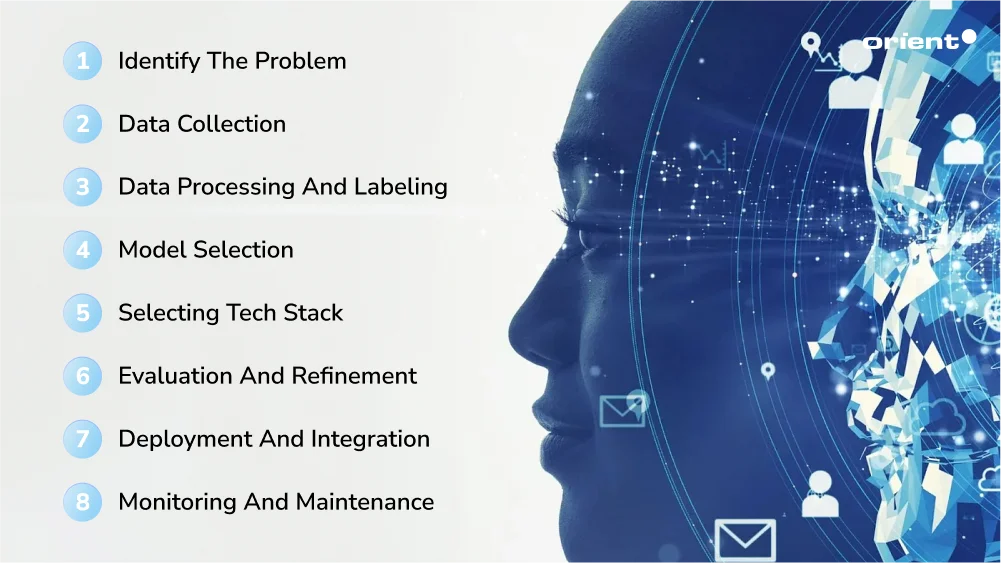
How to Build Generative AI Solutions from Scratch

Content Map
More chaptersGenerative AI has been gaining steam since the introduction of ChatGPT in 2022. The boom of generative AI is redefining and reshaping content creation, image generation, and more. Reports from McKinsey have called 2023 “Generative AI’s breakout year” and noted AI’s steady adoption and rising significance. The adoption rate of this technology sees no sign of slowing down, as McKinsey Global Surveys reported that 65% of surveyed companies regularly use Generative AI. This number nearly doubled compared to a survey conducted ten months prior. Businesses have even reported tangible benefits from using generative AI, including cost reduction and an increase in revenues.
The rapid evolution of Generative AI has created a tidal wave of interest. You need to catch the momentum if you don’t want to be left behind. Catching and riding the wave is key to staying competitive. Here is a step-by-step guide to building a profitable generative AI model to help you navigate the latest technology landscape.
Key Takeaways:
- Generative AI is reshaping our lives by producing new content within seconds that meet users’ demands.
- There are several types of Generative AI, including GANs, variational autoencoders, and diffusion models.
- Generative AI creates new content—text, images, audio, and videos - by processing data through its interconnected nodes, using the knowledge it gains from its training data.
- Creating a generative AI solution typically involves 8 steps, from careful problem identification to data collection, and preparation, to picking the right models and tech stack for the solution.
What Is Generative AI?

Even though Generative AI has been such a buzzword these days, not many fully grasp its definition.
Generative AI is a dynamic branch of artificial intelligence that enables machines to autonomously create original content across multiple forms - text, images, audio, and video. Unlike traditional AI, which simply classifies or responds based on programmed instructions, generative AI models are trained on vast datasets, learning patterns, and structures that allow them to produce entirely new outputs. Using advanced neural networks such as transformers, Generative Adversarial Networks (GANs), and variational autoencoders, these systems replicate and innovate, making content that mirrors human creativity. Whether designing art, crafting stories, or generating realistic synthetic data, generative AI is transforming creative industries and sparking new frontiers in innovation.
Types of Generative AI

Generative AI models can be broken down into several types. In today’s article, however, we will only examine Generative Adversarial Networks, Large Language Models, and Diffusion Models. In addition to the types discussed within this article, other types of Generative AI include Variational Autoencoders (VAEs), Transformer-based Models, Recurrent Neural Networks, etc.
Generative Adversarial Networks (GANs)

A generative adversarial network, or GAN, contains a generator and a discriminator. It trains these two neural networks against one another from a given training dataset. The generator generates new data by modifying the input data sample as much as possible. The discriminator learns to distinguish whether the generated data is fake or real or if the new data belongs to the original dataset.
The process continues until the discriminator can no longer distinguish fake data from original data. In other words, the generator creates more accurate results.
Large Language Models

A large language model (LLM) is an advanced AI technology built on transformer-based neural networks trained on massive datasets to understand and generate human-like text. These machine learning models excel in tasks like translation, summarization, question answering, and text generation. With millions of parameters, LLMs power applications across various fields, enabling chatbots, virtual assistants, and other natural language processing (NLP) tools to perform tasks that mimic human language understanding.
Diffusion Models

Diffusion models are a class of AI. Being a generative model, it produces new data based on its training data set. Diffusion models gradually transform random noise into a clear output. It learns this process by first adding noise to images during training and then studying how to reverse it to reveal the original data. Once trained, the model can take random noise and “denoise” it step-by-step, generating realistic content based on its learned patterns. This technique allows diffusion models to produce detailed and lifelike results, and it is widely used in image and audio generation.
Here Is How Generative AI Works

Generative AI creates new content by using neural networks to find patterns and structures in existing data. Neural networks are one type of computing architecture that teaches AI to process data the way human brains do. They leverage a layered structure of interconnected processing units, or “nodes,” to pass data to one another. They are also used in deep learning.
A generative AI solution is fed a massive amount of structured and unstructured data that is transformed into numerical representations. After being filtered and classified and moving through several computational steps, meaningful data is produced.
Generative AI is penetrating not only the tech industry but all fields of our daily lives and work industries via:
- Content creation tools: Jasper AI or Copy.AI
- Automatic language translation: Google Translate or Samsung’s live translation feature
- Chatbots
- Image generation tools like Dall-E
Above are only some of the most notable examples of generative AI in our daily and working lives. AI is utilized in numerous sectors, like healthcare (medical imaging) or finance for fraud detection. AI is quickly reshaping how we operate and make decisions.
Build Generative AI Solutions in Eight Steps

Step 1: Identify the Problem
Why do you want to build a generative AI solution?
Every software development project works toward some end goal, whether it is generating human-like computer voices, summarizing long paragraphs of research papers, or an AI tool that generates new images from a few simple prompts.
This first step is crucial, as it lays down the landscape for every following step. The more detailed this step, the easier and faster it is to proceed.
Step 2: Data Collection
Building a generative AI naturally comes with thorough data collection steps. The AI model needs to be fed massive amounts of data to produce high-quality responses that meet the customer’s expectations. Key points of data collection include:
- Identifying the right data sources to ensure data quality and authenticity. The data can come from sensor outputs, web scraping, etc. Double-check to make sure the data is relevant and accurate in the matter the model is trained in.
- The collected data should be large in volume and vast in diversity. The more diverse the data you feed to the AI model, the more diverse and better the answers overall.
- Generative AI is only as good as the data you use to train it. Hence, make sure to process and clean the data, e.g., remove duplicates or handle missing values, to ensure the data used is of the highest quality.
- Check for ethical and legal compliance of your data.
- Implement data management tools to keep track of the changing data as the generative AI solution evolves. This ensures a structured AI development.
Step 3: Data Processing and Labeling
After being collected, the data is prepped for AI training. This includes cleaning, normalizing, and augmenting the data.
- Data cleaning removes any errors and inconsistencies.
- Data normalizing ensures a uniform data scale.
- Data augmentation diversifies the dataset.
The data then extracts key characteristics from the raw data, improving model performance. It also goes through training, validation, and test sets and is manually or semi-automatically categorized or labeled.
Step 4: Model Selection
After thorough preparation, it is time to choose the AI’s foundational model and appropriate algorithms. Instead of conducting data collection and meticulous preparation, most start-ups use pre-trained models as a starting point to gain access to a quality dataset, accurate model performance, and shorten the time it takes to train an AI model. Some examples of such foundational models are GPT, Amazon Titan, Claude, and BERT. From here, developers can fine-tune the model, significantly shortening the development time.
To choose the right model, teams shouldn’t focus solely on its primary capabilities but also on its additional features and response qualities.
Step 5: Selecting Tech Stack
Best Practices
AI models need to handle large amounts of data. Hence, its architecture needs to be robust while performing and scaling well.
To achieve this, some of the best practices include:
- Breaking down the AI solution into small, manageable components. In other words, microservices architectures are a great choice for developing generative AI solutions.
- Implement load balancing to achieve peak performance and prevent crashing.
- Implement message queues to establish effective communications between the solution’s components.
- Use caching to reduce backend requests.
- Customize the model’s metrics like batch size, dropout rate, etc.
Tech Stack
Here is a quick overlook of a generative AI solution tech stack that is scalable, reliable, and ethical.
- Foundation models & pre-trained models: GPT for text generation, DALL-E and Stable Diffusion for image generation, and Codex for code generation.
- Deep learning libraries and frameworks: TensorFlow, PyTorch, and JAX
- Data handling and processing: Pandas, NumPy, Matplotlib
- Model optimization and acceleration: ONNX, TensorRT
- Model deployment and serving: TensorFlow Serving or TorchServe, paired with containerization (e.g., Docker) and orchestration (e.g., Kubernetes)
- MLOps & model lifecycle management: Kubeflow or MLflow
- Edge deployment and mobile integration: TensorFlow Lite or Core ML
- Inference serving and scaling: NVIDIA Triton Inference Server and KFServing
- Ethics, bias, and fairness tools: Fairlearn or IBM AI Fairness 360
Step 6: Evaluation and Refinement
After training, you need to gauge and refine the model’s performance. This is a constant process. This step can be done by an in-house team or you can outsource QA experts.
Whatever method you choose, here are a few key ideas to keep in mind:
When evaluating the model, use BLEU, ROUGE, or METEOR metrics for text generation. Track loss functions to gauge prediction accuracy. Conduct manual inspections to uncover any errors or biases that quantitative metrics might miss.
Model refinement involves optimizing parameters, adjusting the solution’s structure, and using techniques like transfer learning to improve performance. Continuous improvements are made by gathering user feedback, monitoring for data changes, and testing robustness through simulated challenges.
Step 7: Deployment and Integration
After rigorous preparation and testing, it’s time to set up cloud computing systems or on-premise infrastructure for the right deployment environment, depending on the requirements. Carefully set up hardware and software for the operating systems, databases, and servers. Don’t forget the frameworks and libraries essential for running the AI solution. Lastly, set up continuous integration and deployment (CI/CD) pipelines with tools like Gitlab.
Step 8: Monitoring and Maintenance
All the hard work doesn’t end at the deployment step. Monitoring the solution’s performance is just as important. Keep a close eye on the metrics and gather feedback from users. From there, refine the algorithms, fix bugs, and update the solution with the latest technologies.
How Orient Software Can Help

Orient Software excels not only in generative AI solutions but also in other AI domains. We deliver exceptional generative AI solutions along with a wide range of AI services for healthcare, finance, education, and e-commerce. Our team of experts understand the demands and challenges of AI innovation, so we offer cost-effective and ethical AI services, tech-ready assessments, and a team of seasoned professionals.
With Orient Software, you get the complete package to bring your AI vision to life -from concept to deployment. Book a consultation with us today and start your journey with AI!






